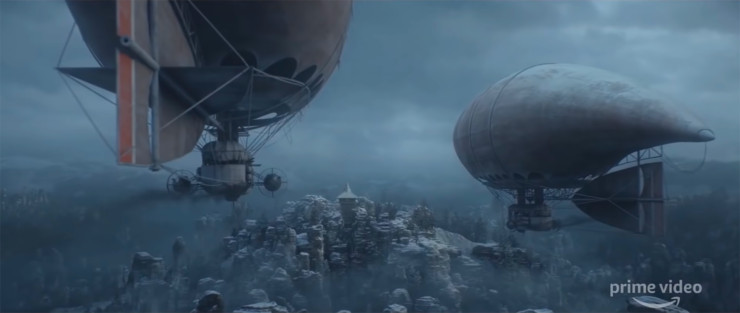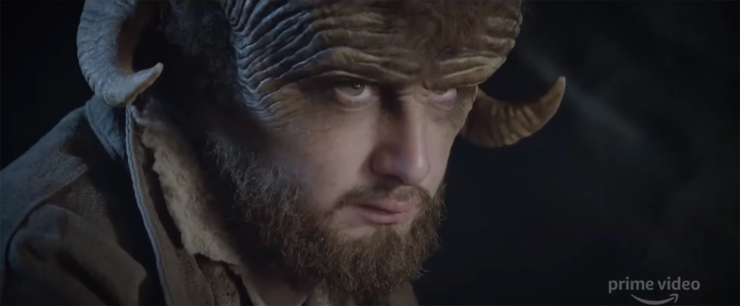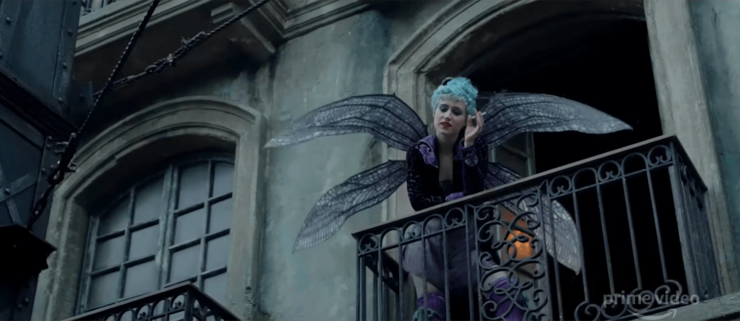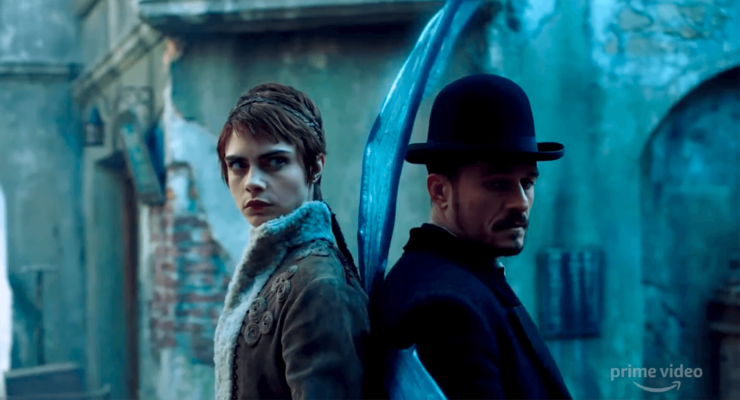I study Victorian Gothic fiction and am an avid fantasy aficionado, so when Amazon Studios announced Carnival Row, a Victorian-adjacent fantasy series, I fully expected that I would either love or hate it. Now, having binged the eight episodes of the first season (it was renewed for season 2 before it aired), I can say that, much to my surprise, my personal reaction is closer to the former than the latter. It’s a pretty good show and—if it is not necessarily the successor to Penny Dreadful, my favorite series of all time and the crowning jewel of Victorian prestige TV—it is definitely a thoughtful entry that, unlike a lot of media that uses 19th century England as inspiration, is very concerned with the content as well as the look of the Victorian world. Carnival Row is, in essence, a show interested in using both the tropes of fantasy and the tropes of Victorian literature to discuss the multifarious social ills caused by racial inequality and colonialism. And, though it can be at times heavy-handed—and, very occasionally, lazily anachronistic—it does a pretty good job of creating an immersive world that resonates with the evils of the present day.
Based on the college film script of screenwriter Travis Beacham (whose previous work includes Pacific Rim and the remake of Clash of the Titans) which was famously included on the 2005 edition of “the Blacklist” (a list of the best un-produced film scripts in Hollywood), Carnival Row is a mosaic story about the Burgue, the eponymous capitol of a Republic which is seven years out from a disastrous war with (and attempt to colonize) Tirnanoc, a continent populated by many species of feyfolk, from the winged faeries, to the horned and hooved fauns, to the diminutive Kobolds. It focuses on both Rycroft Philostrate (Orlando Bloom), an inspector for the Burgue’s constabulary and his ex-lover, Vignette Stonemoss (Cara Delvingne), a coyote (in the immigration sense) for faeries seeking to flee the war-torn remnants of Tirnanoc. The majority of the show’s plots paint the tensions between humans and non-humans (dubbed “creatures” or “cretch” in the in-world racist lingo) as code for racism in a particularly Victorian way.
Realism, Romanticism, and the Steampunk Fallacy

Before we get into the ways in which Carnival Row faithfully inhabits a Victorian world without sacrificing its desire to comment on more current events, it’s important to talk about what Victoriana is. Here is my briefest primer on what “Victorian” means. For something to be Victorian it needs to be from Great Britain (or, sometimes, from the British Empire beyond the Isles) during the reign of Queen Victoria (1837-1901). If it’s from another place during that time-span, we usually refer to it as a 19th-century work (e.g. Moby Dick is a 19th-century American novel, not a Victorian one). If it is from outside of those dates, it usually uses another term to describe the British Monarch of the time. Jane Austen novels are from the Regency (i.e. the reign of the Prince Regent George IV from 1795-1820) whereas E.M. Forster novels are from the Edwardian Era (i.e. the reign of Victoria’s son, King Edward VII from 1901-1910).
But obviously, when we talk about a show like Carnival Row being “Victorian” we usually mean that it is reminiscent of that era in some way shape or form. And here is where we need to make a point about what Victorian-inspired media (or what some call “Victoriana”) isn’t. In fact, the very idea that a show in 2019 would be interested in unfolding like a Victorian novel is deeply surprising. This is largely because of the rise of steampunk as a genre of speculative fiction. I have, dismayingly, seen a lot of reviewers, both in the run-up to the premiere and their coverage of the series, describe Carnival Row as a steampunk show. It is most certainly not a steampunk show. And, while I could likely spend several articles worth of rage excoriating people for the assumption of a fantastical Victorian setting as tantamount to steampunk, I think the most important distinction to make between Victoriana (whether fantastical or no) and steampunk is central to Carnival Row’s ethos. That point is my paraphrase of an excellent lecture I attended by Dr. Mike Perschon in 2009: At its core, steampunk is a genre that is optimistic about technology and pushes a meritocratic worldview where, in order to rise high, all one needs is a keen intelligence and access to a scrap heap. By contrast, the scholarly self-assessment of the Victorian era (and certainly the central point of Carnival Row) is a fundamentally pessimistic vision of a stagnating world where technological advancements serve to highlight deep social iniquity and strife.
The dominant mode of Victorian and Victoriana literature is realism—not realism that stands in opposition to speculative fiction, but realism that stands in opposition to the confident optimism of the Romantic era. Even the Victorian literature that draws on settings or themes that we might see as similar to steampunk (think H.G. Wells or some of the works of Edward Bulwer-Lytton and Robert Louis Stevenson) usually is fixated on the social horrors accentuated by technological advancement rather than the adventurous possibilities. Kate Beaton’s excellent comic about the difference between Victorian author H.G. Wells and 19th century French author Jules Verne is super useful in illustrating this point. Carnival Row is fundamentally uninterested in technology and especially uninterested in technology as a solution to social evil. Instead, it is deeply concerned with the storytelling practices of the Victorian novel.
Fauns and Trolls and Dickens and Trollope

Where Carnival Row departs from not only the steampunk flavor of much of our Victorian-inspired speculative fiction, but from much of the fantasy and science fiction that has been part of the post-Lord of the Rings films revival is in its dedication to telling a story about systems. Specifically, like its Victorian predecessors, it is interested in telling a story about an intricately interconnected social order where the urban landscape makes it impossible to live apart from those who are much richer or much poorer. Charles Dickens was perhaps the master of this particular set of tropes, though you can absolutely find it in the works of George Eliot, Elizabeth Gaskell, Anthony Trollope, and Wilkie Collins among many others. Rather than tell the story of a single character or set of characters, Victorian novelists often tell sprawling yarns that encompass people from many different social strata, engaged in seemingly unrelated plots which turn out to be, if not perfectly interlinked, at least part of a rich portrait of a polity (often, but not always, London).
Carnival Row’s The Burgue, a wealthy city-state modeled on 19th-century London, is the unifying glue of its many plots. While nearly every plot in the first season ends up being at least tangentially related to the main plot—Philostrate’s murder investigation—they are all given quite a bit of life and screen time beyond the main mystery. And it is in these that we see even more of a reverence for the kinds of stories that Victorian novels were adept at telling. The political machinations of Chancellor Breakspeare (Jared Harris) and his wife (Indira Varma) feel like a campier, magically tinged take on Trollope’s Plantagenet novels. Trollope’s The Way We Live Now seems to be the inspiration for the tale of the financially ruined Spurnrose siblings (Tamsin Merchant and Andrew Gower) and their testy relationship with nouveau riche faun Agreus Asteryon (David Gyasi). Elsewhere, there are shades of Thomas Hardy in the cycles of scandal and disappointment that plague the romance between Philostrate and his landlady (Maeve Dermody). And the volatile fortunes of itinerant theatrical impresario Runyan Millworthy (Simon McBurney) feel like a Dickensian side plot, complete with warm, comedic affection for the those members of society that have fallen from the bottom rung of the ladder.
There are, of course, outliers to these Victorian sensibilities. The main murder investigation, though clearly inspired by the Jack the Ripper murders (an early plot point even involves a serial killer named “Unseelie Jack”) feels far more like a gritty noir than a Gothic yarn à la Wilkie Collins or Vernon Lee. And the sapphic yearnings of poet-turned-sex worker Tourmaline Larou (Karla Crome) obviously would have been too scandalous for a Victorian novel. But overall, there is a careful attention, almost at the expense of its fantastical setting, to the kind of social realism, chamber dramas, and sensation novels that its aesthetic setting was famed for.
Topsy-Turvy Tropes

Beyond merely recreating familiar-feeling plots, Carnival Row excels at making its Victoriana feel prescient, pressing, and important. It is, after all, a show about race, colonialism, immigration, and Empire. The essay collection Victorian Prism: Refractions of the Crystal Palace (2007), edited by James Buzard, Joseph W. Childers, and Eileen Gillooly, gathers a series of academic works that place the Great Exhibition of 1851 and its centerpiece, the Crystal Palace, as a metaphor for the Victorian experience of Empire. Essentially, while the Great Exhibition positioned itself as a catalogue of all the cultures of the world, it ended up creating a refraction of the Victorian population, only able to see their own Imperial aspirations reflected.
The opening credits of Carnival Row are a play on the Great Exhibition: a series of faeries, fauns, kobolds, and centaurs displayed in a museum, measured with rulers, sealed under glass, captured in zoetrope, and weighed down by scientific sketches and notes. At one point, we see a child’s hand reaching for the hand of a faun that has been placed in a glass display case. But rather than serving as a metaphor for the invisible distinctions between people of different races, we know the faun is dead and the child is reaching out, not in camaraderie, but in wonder at the oddity put on display for their amusement. It is a chilling, and entirely apt depiction of the ways in which Empire claims to serve both colonizer and colonized while dehumanizing the latter as a curiosity to be fetishized. The series is even named for the Burgue’s faery ghetto: not a slum but an amusement park to be enjoyed by outsiders.
This is also reflected in the plotting of Carnival Row’s central mystery (WARNING: MAJOR SPOILERS AHEAD).
The series sets up its central plot as a forbidden romance between human (Philostrate) and faery (Vignette). By the third episode, however, it is revealed that Philostrate is, himself, a faery whose wings were shorn in infancy. While this dovetails with 19th-century American “tragic mulatto” plots and is almost precisely the central conceit of George Eliot’s 1876 Daniel Deronda (with Judaism swapped for faery heritage), it also cuts heavily against the often tone-deaf implications of oppressor-falls-in-love-with-oppressed forbidden romances. The series even comes dangerously close to a too-on-the-nose meta-discussion of its own flirtations with the genre when Philostrate and Vignette argue over an in-world piece of fiction that the latter initially dismisses as “a colonialist fantasy.”
Furthermore, the series manages to subvert the colonialist trope of supernatural horror being the domain of the colonized. This trope can be purely sensational and dehumanizing (like the zombie films of the 1950s that show decent white men being targeted by dark-skinned voodoo practitioners) or can be played as a satisfying revenge tale (like the Golem of Prague where a rabbi uses kabbalistic magic to take revenge on the Holy Roman Empire). One of the more interesting cases can be found in Rudyard Kipling’s 1925 short story “The Mark of the Beast” where British colonial officers in India are justly punished for desecrating a statue of Hanuman. Given Kipling’s uncomfortable, complicated, and ultimately damning role in the promotion of British colonialism, his Gothic and supernatural stories about the Indian frontier are especially complex and difficult to unpack versions of the trope.
Carnival Row turns the entire project on its head by having its murderer conduct their attacks through an undead chimera called a Dark Asher—animated through dark faery magic. With a faery Haruspex, a revolutionary faun cult of self-mortification, and endless dissatisfied non-humans in the foreground, all signs point to the Dark Asher’s controller being a revenge-seeking faery. When the murderer turns out to be [highlight whited-out text to read spoilers] Piety Breakspeare (Indira Varma), the human wife of the Burgue’s Chancellor, the show gives us a clever inversion of the colonialist trope. The savage monster turns out to be the oppressor, purposefully using the signs of the oppressed to remain unseen. The show is often heavy-handed in its underscoring of these themes, but it manages to be a much more thoughtful and engaging look at tropes that are often blindly used to racist ends.
Ultimately, Carnival Row, is an imperfect series whose careful study of the Victorian era and dedication to stories about racism, oppression, and colonialism is sometimes undercut by poor pacing, uneven writing, and, frankly, the somewhat middling acting talents of its two (admittedly very pretty) stars. It also suffers from many of the issues we have come to associate with prestige TV. There is a lot of female nudity that can feel gratuitous. In general, its female characters feel less well developed than their male counterparts, and nearly all of them end up being the villains of the show where male characters turn out to be unexpectedly heroic. There are also some uncomfortable casting choices given the show’s colorblind ethos. Seeing as human vs. faery is the relevant axis of oppression, the show casts many people of color as wealthy oppressors and many white actors as oppressed. This mostly has the effect of allowing the audience to see past skin color as a meaningful metric in Beacham’s world. But in casting David Gyasi as the wealthy faun seeking to make it in the human world, the show blunders into some uncomfortable colorist implications, especially where his romance with Tamsin Merchant’s lily-white Imogen Spurnrose is concerned.
All of that said, the series is certainly worth a watch. It ends on a note of dark uncertainty that promises that its sadly relevant exploration of ghettoization, pogroms, and scapegoating of racial minorities will be placed even more front and center next season. It is also a meticulously built world with all kinds of engaging visual touches (such as the sex workers all dyeing their hair teal, or people keeping bears as house pets instead of dogs) that make it feel like a much better-thought-out fantasy world than we are used to seeing on television (Game of Thrones excepted). And of course, just on a personal note, I am always happy to see a new show or movie that might convince fans to pick up a copy of Bleak House.
Tyler Dean is a professor of Victorian Gothic Literature. He holds a doctorate from the University of California Irvine and teaches at a handful of Southern California colleges. He is one half of the Lincoln & Welles podcast available on itunes or through your favorite podcatcher. More of his writing can be found at his website and his fantastical bestiary can be found on Facebook at @presumptivebestiary.










